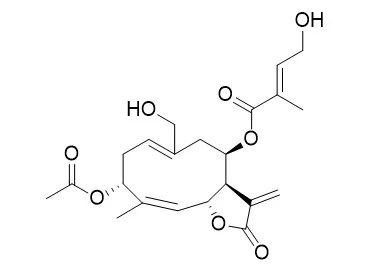| In vitro: |
| Nat Prod Res . 2019 Feb;33(4):477-485 | | Precise discovery of a STAT3 inhibitor from Eupatorium lindleyanum and evaluation of its activity of anti-triple-negative breast cancer[Pubmed: 29086600] | | Michael reaction acceptors (MRAs) are a class of active compounds. There is a great prospect to screen STAT3 inhibitors from Eupatorium lindleyanum, furthermore, to discover lead compounds for anti-triple-negative breast cancer (TNBC). In this study, glutathione (GSH) was employed, and a UPLC-MS screening method was developed to discover MRAs. We screened MRAs which can inhibit STAT3 using a STAT3-dependent reporter system. Six sesquiterpene lactones, including a new compound Eupalinolide O (1), together with five known compounds, Eupalinolide I (2), Eupalinolide K (3), Eupalinolide H (4), Eupalinolide J (5) and Eupalinolide G (6) were isolated. Eupalinolide J was identified as MRA that decreased luciferase activity of STAT3. Preliminary activity assessment showed that Eupalinolide J could inhibit the viability of TNBC cell lines. We demonstrated that Eupalinolide J, which is a natural typical MRA, has a notable inhibition of STAT3 activity and a potential cytotoxic activity against TNBC cell lines. | | J Asian Nat Prod Res . Apr-Aug 2007;9(3-5):339-45. | | Cytotoxic sesquiterpene lactones from Eupatorium lindleyanum[Pubmed: 17613619] | | Three new germacrane sesquiterpenes, eupalinolides C-E (1-3), along with three known germacrane sesquiterpenes, eupalinolide A (4), eupalinolide B (5), and 3beta-acetoxy-8beta-(4'-hydroxytigloyloxy)-14-hydroxycostunolide (6), were isolated from Eupatorium lindleyanum. They were tested for cytotoxicity against A-549, BGC-823, SMMC-7721, and HL-60 tumour cell lines. The results showed that these compounds demonstrated potent cytotoxicity. The structures of the compounds were elucidated by means of (1)H and (13)C NMR spectroscopic analysis, including 2D NMR experiments. | | Planta Med . 2018 Jan;84(2):123-128. | | Potential Anti-inflammatory Sesquiterpene Lactones from Eupatorium lindleyanum[Pubmed: 28793356] | | Eupatorium lindleyanum has traditionally been used as folk medicine in Asian countries for its therapeutic effects on tracheitis and tonsillitis. Investigation of the anti-inflammatory active constituents from E. lindleyanum led to the isolation of two novel sesquiterpene lactones, named eupalinolide L (1: ) and eupalinolide M (2: ), and seven known sesquiterpene lactones (3: -9: ). The structures and configurations of the new compounds were determined on the basis of spectroscopic analysis, especially 2D NMR techniques. In vivo experiments showed that the sesquiterpenes fraction significantly reduced mouse ear edema induced by xylene (18.6%, p < 0.05). In in vitro assays, compounds 1: -9: showed excellent anti-inflammatory activities, as they lowered TNF-α and IL-6 levels in lipopolysaccharide-stimulated murine macrophage RAW 264.7 cells (p < 0.001). The above results suggest that the sesquiterpene lactones from E. lindleyanum can be developed as novel potential natural anti-inflammatory agents. |
|






 Cell. 2018 Jan 11;172(1-2):249-261.e12. doi: 10.1016/j.cell.2017.12.019.IF=36.216(2019)
Cell. 2018 Jan 11;172(1-2):249-261.e12. doi: 10.1016/j.cell.2017.12.019.IF=36.216(2019) Cell Metab. 2020 Mar 3;31(3):534-548.e5. doi: 10.1016/j.cmet.2020.01.002.IF=22.415(2019)
Cell Metab. 2020 Mar 3;31(3):534-548.e5. doi: 10.1016/j.cmet.2020.01.002.IF=22.415(2019) Mol Cell. 2017 Nov 16;68(4):673-685.e6. doi: 10.1016/j.molcel.2017.10.022.IF=14.548(2019)
Mol Cell. 2017 Nov 16;68(4):673-685.e6. doi: 10.1016/j.molcel.2017.10.022.IF=14.548(2019)